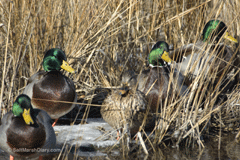Salt Marsh Diary
Air Date: Week of February 6, 2009

Mallards waking up.(Photo:© Salt Marsh Diary)
Writer Mark Seth Lender observes a flock of mallards on a Connecticut river bend.
Transcript
[MUSIC: Vinicius Cantuaria “Sem Pisar No Chao” from Sol Na Cara (Rykodisc 2006)]
Well, Charles Darwin wanted to visit the United States – but he never did. If he had, we think he would have liked an expanse of river and salt marsh along the coast of Connecticut. It’s about 90 minutes from Manhattan, a place filled with wildlife and wonder for writer Mark Seth Lender.
LENDER: At the bend in the river a flock of mallards is dozing in tall grass that is winter-bleached and battered by snow, by wind, by high water. Worn thin, there is little cover in it but it is all the mallards have and must make do. In these river narrows, in the tie-downs of the straights and shallows, their only true refuge is day sleep. The pulse drops, the body stops except for the low breath and the least heat it needs to keep on living. Even the sun is cold. And the mallards hold.
They are an average flock, these mallards. Still as the ice grounded to the bank. Closest are four drakes, laid up with their bills tucked to the crook at the back of their necks. Positioned this way their heads are a virtual black so dark it is not a color but a gap. Sensing my presence the drakes, in consort, look up. And a curious thing. That gap fills with an iridescence, so brilliant, reminiscent more of a scarab’s shell than the soft hue of feathers.
It is the angle between the shafts. Heads bent, the feathers spread. Light falls straight in and vanishes. Only when the drakes unfurl themselves do the feathers relax and close and the full green flash of plumage, bright as a lighthouse, beacons forth. The object of all this stands between them, a single hen, invisible as an afterthought. Movement reveals her and (now that she is standing) so do her very orange feet. The color is a sign that breeding is imminent, though the choosing is not yet complete. It is for her the drakes risk themselves this way and hide as best they can when they sleep. For the need runs deep and the mallards stay.
.gif)
Mallards dozing. (Photo:© Salt Marsh Diary)

Mallards waking up. (Photo:© Salt Marsh Diary)
I want to lie down beside them there on the spongy bank, nestle my face into the warm hollows of their wings and feel the pulse and listen to them breathe. But I must leave. Not out of fear nor because I am riven by the frigid air and not because I want to. I am comforted here. As if I belong here. As I am sure we used to before we knew what we know and wish we did not.
GELLERMAN: Mark Seth Lender writes a syndicated column called “Salt Marsh Diary.” He also takes photographs of the place – you can see some at our website, loe.org.
[MUSIC: Marco Benevento “Sing It Again” from Me Not Me (Royal Potato Family 2009)]
GELLERMAN: Just ahead: burn baby burn – wood keeps houses warm and snug – but ignites a firestorm of controversy - Stay tuned to Living on Earth.
ANNOUNCER: Support for the Environmental Health Desk at Living on Earth comes from the Cedar Tree Foundation. Support also comes from the Richard and Rhoda Goldman fund for coverage of population and the environment. And from Gilman Ordway for coverage of conservation and environmental change. This is Living on Earth on PRI, Public Radio International.
Links
Living on Earth wants to hear from you!
Living on Earth
62 Calef Highway, Suite 212
Lee, NH 03861
Telephone: 617-287-4121
E-mail: comments@loe.org
Newsletter [Click here]
Donate to Living on Earth!
Living on Earth is an independent media program and relies entirely on contributions from listeners and institutions supporting public service. Please donate now to preserve an independent environmental voice.
NewsletterLiving on Earth offers a weekly delivery of the show's rundown to your mailbox. Sign up for our newsletter today!
 Sailors For The Sea: Be the change you want to sea.
Sailors For The Sea: Be the change you want to sea.
 The Grantham Foundation for the Protection of the Environment: Committed to protecting and improving the health of the global environment.
The Grantham Foundation for the Protection of the Environment: Committed to protecting and improving the health of the global environment.
 Contribute to Living on Earth and receive, as our gift to you, an archival print of one of Mark Seth Lender's extraordinary wildlife photographs. Follow the link to see Mark's current collection of photographs.
Contribute to Living on Earth and receive, as our gift to you, an archival print of one of Mark Seth Lender's extraordinary wildlife photographs. Follow the link to see Mark's current collection of photographs.
 Buy a signed copy of Mark Seth Lender's book Smeagull the Seagull & support Living on Earth
Buy a signed copy of Mark Seth Lender's book Smeagull the Seagull & support Living on Earth

